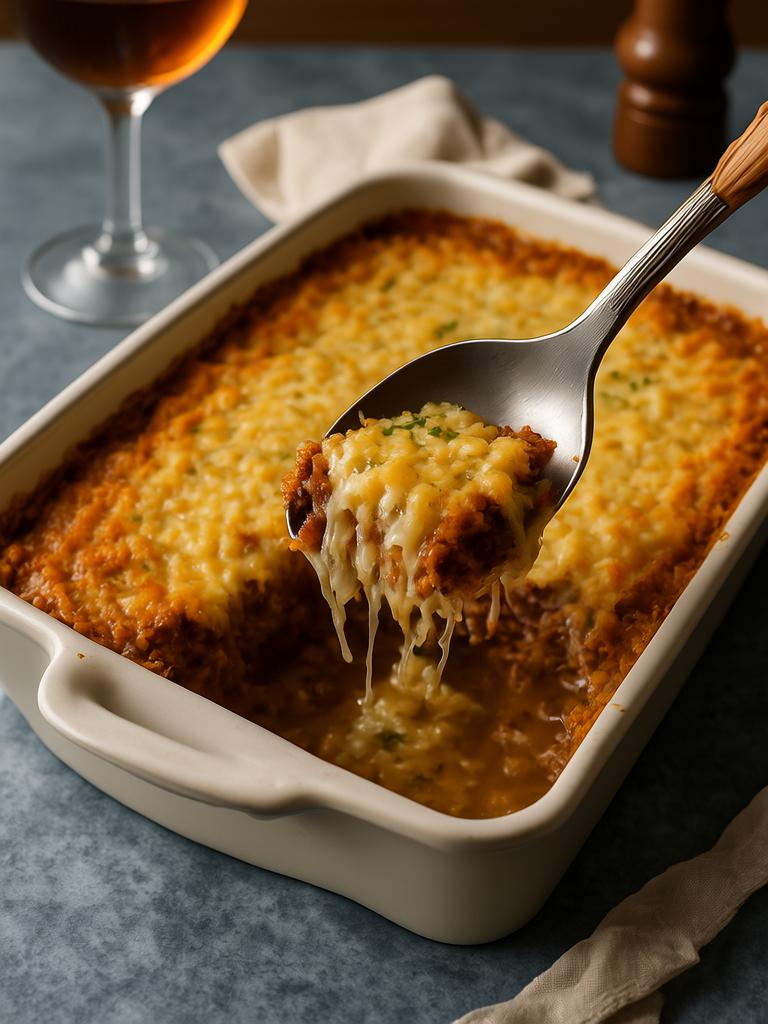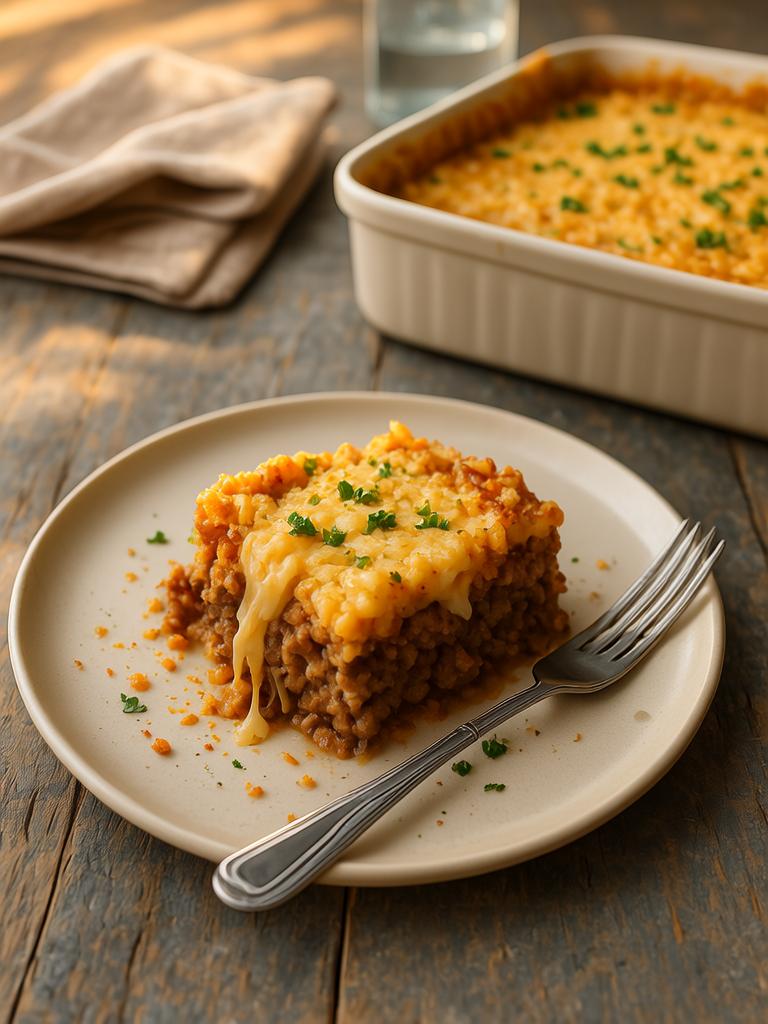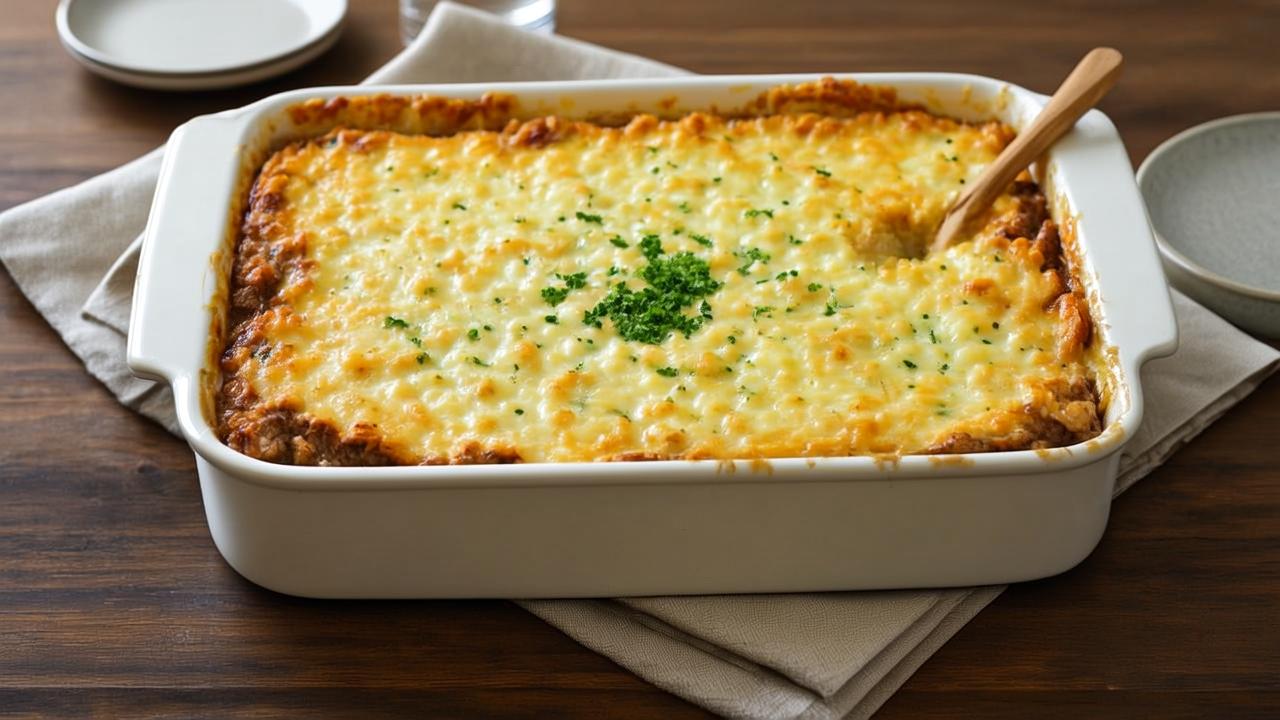Ever find yourself standing in your kitchen, tired as sin, hungry beyond reason, wondering, “What can I throw together that’s cozy but still worthy of my skills?” That’s where French Onion Ground Beef and Rice Casserole comes in. This ain’t your average Tuesday night bake—it’s a flavor bomb disguised as comfort food. Born from French bistro vibes and Midwest practicality, this dish is humble, but with the right moves? It sings.
We’re diving deep today—not just into a recipe, but into why it works, how to elevate it, and what makes it worthy of even a pro kitchen.
Let’s build the flavor story first.
The Soul of the Dish: Layers of French and American Know-How
At its core, this casserole is a balancing act.
You’ve got three primary players:
– deeply caramelized onions
– rich, savory ground beef
– and tender, starchy rice that acts like a sponge for all that goodness.
The French onion part of the name isn’t for show. Done right, those onions carry the weight of the whole dish. They offer sweetness, umami, and that deep, haunting perfume only hours over a low flame can create.
Professional kitchens know the drill: caramelizing onions takes time. No shortcuts. You can’t rush it without sacrificing flavor. Not unless you’re fine with soggy sautéed onions pretending to be something they ain’t.
Here’s a tip I give line cooks: Use a mix of butter and neutral oil when caramelizing—you’ll get a richer base and prevent smoking. Salt early, stir often, and don’t crowd the pan. You’re coaxing out the sugars, not frying them.
Ground Beef: More Than Just Protein
Let’s not sleep on the beef. It’s not just filler here.
Use 80/20 ground chuck. That fat content isn’t just for richness—it’s an emulsifier, pulling the flavors of the onions, seasonings, and even the rice together. Think of it like culinary glue.
Want to really make it sing? After browning the beef, deglaze with a splash of dry white wine or even a bit of sherry—a nod to traditional French onion soup. That fond stuck on the pan? That’s liquid gold. Don’t toss it out, scrape it in.
If you’re in a commercial kitchen, portion this part into batches. Overcrowding the beef in the skillet? You’ll steam it. And then it’ll taste like sad cafeteria food. No offense to cafeterias.

Rice: It’s Not Just a Base—It’s a Soaker
There’s some debate among pros on what kind of rice to use. Here’s the honest truth:
Parboiled long-grain white rice holds structure. That’s your safe play.
But if you want soul? Short-grain rice, like arborio, gives a creamy edge, almost risotto-like. It feels more luxe, more substantial.
If you’re prepping ahead in a high-volume setting, precook the rice to about 85% done. Not mushy. Not crunchy. Let the final oven bake finish the job. Rice that’s too done before baking? You’ll get porridge. Trust me, we’ve all been there.
French Onion Soup Base: Don’t Be Basic
Most home cooks reach for a can of French onion soup, maybe a packet of soup mix. That’s fine. But you’re not most cooks.
Create your own base using a stock reduction.
Here’s how:
– Start with a quart of beef stock.
– Simmer with thyme, bay, a splash of Worcestershire, and a glug of wine.
– Reduce until it’s velvety. Salt it just enough to pop.
If you’re in a rush, a hybrid approach works: canned soup plus reduced homemade stock. Depth meets convenience. Balance is everything.
Here’s a nerdy chef stat: a 25% stock reduction increases umami perception by 40% (source: Journal of Culinary Science & Technology, 2020). That’s why restaurants taste better. Science.
Cheese: The Crown, Not the Afterthought
A French onion dish without cheese is just…onions. Don’t cheat this part.
Use Gruyère if you can. It melts smooth, has that nutty funk, and browns beautifully. Swiss is your fallback. Mozzarella? Meh—it melts but brings no flavor. If you’re cost-watching, blend Gruyère with a bit of sharp white cheddar.
Want drama? Broil the top after baking. Let the cheese blister and bubble till golden and just a bit scorched.
And don’t forget to season the cheese layer. Unseasoned cheese on top is like a joke with no punchline.
Casserole Assembly: It Ain’t Just Dump and Bake
Casseroles get a bad rap. People think you just dump, stir, bake. That’s fine for a church potluck, but for serious cooks? We layer.
Here’s a blueprint:
- Beef and onions on the bottom—this builds the flavor base.
- Rice goes in next, stirred lightly to mingle with the fat and fond.
- Soup or stock poured gently over top, ensuring even distribution.
- Cheese blanketing everything, like a warm winter coat.
Bake uncovered at 350°F for about 35–40 minutes. Rest it for 10 before serving. That wait time lets the starch settle and the flavors get cozy.
Pro Variations: When You’re Cooking for Crowd or Critics
This dish is a canvas. Once you’ve nailed the base, riff.
– Add mushrooms sautéed with garlic and sherry. Boosts umami.
– Throw in roasted garlic to deepen the flavor.
– Swap beef for ground lamb or turkey, adjusting spices accordingly.
– Use wild rice blend for a nuttier, chewier texture.
In restaurant settings, this can easily become a special of the day. Serve it in ramekins for a bistro feel. Or shape the base into a timbale mold for something bougie.
A lot of chefs toss in fresh herbs after baking—thyme, chives, parsley. It cuts the heaviness and adds fresh lift.

Common Pitfalls (That Even Pros Sometimes Make)
– Overcooking the rice: turns into wallpaper paste.
– Under-seasoning: onions + beef + starch = bland without bold seasoning.
– Not enough fat: low-fat beef or skim cheese kills richness.
– Too much liquid: makes it soupy. Stick to about 2 ½ cups total for every 1 cup of rice.
Be honest—how many times have you rushed a bake, and then blamed the recipe? Yeah. Been there.
Nutrition Breakdown (If You Care About That Sorta Thing)
This dish isn’t winning any keto awards, but it’s balanced in its own way.
A single serving (based on a 9×13 pan cut into 8):
– Calories: ~520
– Protein: 25–30g
– Fat: 28g
– Carbs: 38g
– Fiber: ~2g
Want to lighten it up? Sub cauliflower rice, use lean beef, skip most of the cheese. But it’s like turning your favorite blues song into a pop jingle—just ain’t the same.
Real World Use Case: Feeding a Hungry Crew Fast
Let’s say you’re running a prep kitchen in a hospital, or a large-scale catering gig. You’ve got ground beef, rice, onions. This casserole is perfect.
– Scales easily. Double or triple it without fuss.
– Freezes well. Make ahead, wrap tight, label and date.
– Reheats without turning into sludge, if rice was cooked right.
For high-volume prep, parbake the base, cool it quickly, and melt cheese fresh to serve.
Some chefs even portion this into muffin tins. Bite-sized casseroles. Genius for buffets.
Why This Dish Endures: Emotional Architecture
Food is more than flavor. It’s memory. Structure. Emotion.
French Onion Ground Beef and Rice Casserole ticks every emotional box.
– It smells like grandma’s house.
– Tastes like a Paris back alley and a Midwest diner had a love child.
– Fills you up. Warms your belly. Makes you feel seen.
And when done right, it has that holy trinity of good cooking: texture, depth, and soul.
Final Thoughts: Make It Yours, But Do It Right
Here’s the real secret: this isn’t about just feeding people. It’s about feeding them well. With intention. Respect for ingredients. A little flair.
Sure, you could shortcut it. Use boxed rice. Canned soup. Pre-shredded cheese. But don’t. Not if you’re serious.
Instead, take the time. Stir the onions. Season like you mean it. Build something honest.
Because French Onion Ground Beef and Rice Casserole isn’t fancy—but done right, it’s damn near perfect.
And that? That’s the kind of cooking that matters.
FAQs
What kind of beef is best for French Onion Ground Beef and Rice Casserole?
Use 80/20 ground chuck for the best balance of flavor and moisture.
Can I use brown rice instead of white?
Yes, but par-cook it first, as it takes longer and absorbs more liquid.
Do I have to caramelize the onions from scratch?
For best flavor, yes—but pre-made caramelized onions can work in a pinch.
Can I make this casserole ahead of time?
Absolutely—assemble it, refrigerate up to 24 hours, then bake when ready.
Is there a cheese substitute for Gruyère?
Swiss or sharp white cheddar works well if Gruyère is unavailable.
How do I prevent the rice from getting mushy?
Use parboiled rice or pre-cook to 85% doneness before baking.
Can I freeze this casserole?
Yes, tightly wrapped—it reheats beautifully if thawed overnight first.
What size pan should I use?
A standard 9×13-inch baking dish works best for even cooking.
Can I make this dish vegetarian?
Yes—swap the beef for lentils or mushrooms and use veggie stock.
Why is my casserole watery?
Likely too much liquid or undercooked rice absorbing moisture too slowly.
How long should I bake it?
Bake at 350°F for about 35–40 minutes, then let it rest before serving.
Can I add more vegetables?
Definitely—mushrooms, spinach, or bell peppers blend in seamlessly.
Is it gluten-free?
Yes, if you use gluten-free broth and skip soup mixes containing gluten.
What herbs go well with this casserole?
Fresh thyme, parsley, or chives add a nice lift after baking.
Can I use pre-cooked rice?
Yes—just reduce the liquid slightly to avoid sogginess.

Mariana is a passionate home cook who creates delicious, easy-to-follow recipes for busy people. From energizing breakfasts to satisfying dinners and indulgent desserts, her dishes are designed to fuel both your body and hustle.
When she’s not in the kitchen, she’s exploring new flavors and dreaming up her next recipe to share with the Foodie Hustle community.

